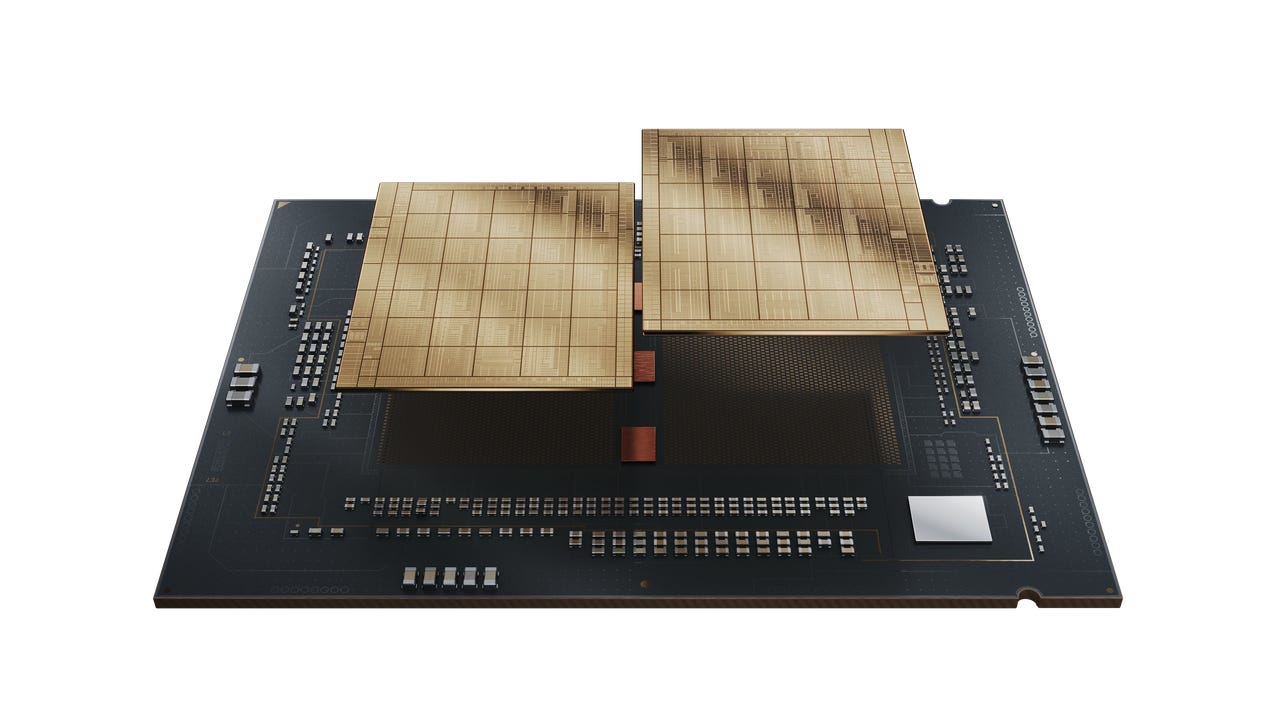Intel spotlights AI in new Core Ultra, 5th-gen Xeon chips


The Intel Xeon server chip includes two compute tiles that have a combined 64 computing cores, each with acceleration for processing neural networks.
Intel CEO Pat Gelsinger on Thursday unveiled the chip giant's latest microprocessors for desktop and server, and showed off a forthcoming AI processor, at a morning event at the Nasdaq Market Site in New York City.
Artificial intelligence is probably "underestimated," said Gelsinger, likely to represent at some point a third of the global economy, but also at risk of consuming a quarter or more of the world's energy if not developed efficiently.
Also: Nvidia sweeps AI benchmarks, but Intel brings meaningful competition
The fourth-generation of Intel's Xeon server, code-named Emerald Rapids, offers performance that is 21% higher, on average, than the previous generation, Sapphire Rapids, said Intel. The new server also makes possible a 36% increase in "average performance per watt," said Intel.
With 64 individual processing cores, the new Xeon can achieve improvements in AI such as speeding up large language model processing by 23%, said Intel's head of data center computing, Sandra Rivera.
The Xeon server will be available in the first quarter of 2024 from vendors including Cisco and Lenovo.
The new desktop chip, Core Ultra, code-named "Meteor Lake," is the first high-volume client computing chip the company is making with the manufacturing technology it calls "Intel 4," which it claims will have 20% greater performance-per-watt compared to the predecessor technology, Intel 7.
The chip, said Intel, represents its "largest architectural shift in 40 years." Among the elements of that shift is the inclusion for the first time of a dedicated accelerator unit for AI, called a neural processing unit (NPU).
Intel CEO Pat Gelsinger [right] -- with CCO Christoph Schell -- shows off the forthcoming third-generation "Gaudi" AI accelerator chip from the company's Habana Labs division.
That NPU circuitry will enable "a new level of power-efficient AI acceleration with 2.5x better power efficiency than the previous generation" of Core chip, said Intel. An on-chip GPU element will also speed up AI, the company said.
PCs with Core Ultra are available now at retail.
In the demo area, Intel showed PCs that used AI for a variety of AI applications. One example is the open-source image-editing program GIMP performing image generation. Using the Intel software framework called OpenVINO, a plugin to GIMP can call the Stable Diffusion open-source program. The Stable Diffusion code will take a text prompt you type and turn it into an image. The OpenVINO will make it run efficiently on the Core Ultra's NPU.
You can already do this with Stability.ai's cloud service, or with a number of other programs such as OpenAI's DALL-E. Intel's point is that GIMP using the NPU doesn't have to have a cloud connection. The demo PC, in fact, had its network connection turned off.
That means less time waiting for results, as the image shows up instantaneously, and no money paid for a cloud subscription with Stability.ai or OpenAI, and the privacy of keeping one's data from going to a remote server. As an Intel engineer pointed out during the demo, even the text prompt used with Stable Diffusion could be considered one's intellectual property. Given that, it might be worth preventing prompts from being sent to a server.
New PCs now available with the Core Ultra chip on display at Intel's event.
In one of the many demos, a plugin to the popular open-source image-editing program GIMP makes use of OpenVINO to call the Stable Diffusion AI program to generate images without a network connection.
Gelsinger ended the keynote by rushing on stage to hold up the forthcoming third version of "Gaudi," the company's dedicated processor for AI, made by Habana Labs.
"Why are we the right ones to build AI?" asked Gelsinger. "We are scale: we build in volume." Gelsinger reiterated the company's pledge to move through five manufacturing technologies in four years, stating, "On track, baby," to whoops and applause from the audience.
Also: Intel advances oneAPI as the all-important 'next click down'
Gelsinger added that 2024 will be "the year of the AI PC...the next PC ecosystem evolution."
Former Intel CEO, the late Andy Grove, noted Gelsinger, "called the PC the ultimate Darwinian device." AI, said Gelsinger, means that "the next step of that Darwinian device is underway."
To show off the Xeon's AI prowess, Intel's Rivera brought on stage Lauren Elliott of game maker Gallium Studios. Gallium is working with AI lab Numenta to use Intel chips to speed up a new video game called Proxy. Proxy uses algorithms that include large language models to play a game with the stored memories that players enter into the game. The intense processing of the data was aided by the Xeon's processing ability, said Elliott.